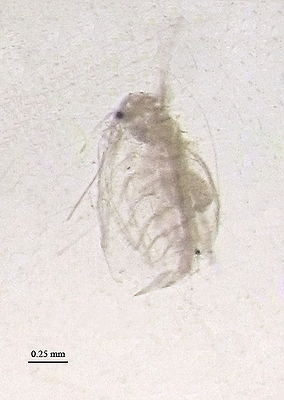Ctenopoda
| Ctenopoda | ||||||||||||
|---|---|---|---|---|---|---|---|---|---|---|---|---|

Penilia avirostris |
||||||||||||
| Systematics | ||||||||||||
|
||||||||||||
| Scientific name | ||||||||||||
| Ctenopoda | ||||||||||||
| Sars , 1865 |
The Ctenopoda represent an order or subordination of the clawed tails (Onychura) and thus within the leaf crabs (Branchiopoda). These are small crustaceans that are mainly found in freshwater, only the genus Penilia lives in the sea. The species are limited in their occurrence to the northern hemisphere ( Holarctic ) and the tropical belt .
Construction of the Ctenopoda
The Ctenopoda reach a maximum body length of 4 millimeters. The body of the animals is surrounded by the shell ( carapace ) typical of the clawed tails and consists of relatively few segments, the boundaries of which are only indistinctly recognizable. It ends in a telson with a short abdominal fork ( furca ). The head does not have a separate head shield.
The first antenna is short and tubular, the second antennae are large two-branched swimming legs with swimming bristles. The maxillae and mandible are normal. The single compound eye is relatively large and is the front of the head, an unpaired Naupliusauge is also available.
The trunk carries six pairs of extremities, with the first five pairs developed into filter legs. The stroke of these legs is metachromic, that is, it moves in waves from one leg to the other, starting with the last pair of legs. As a result, particles can get caught between the leg bases and are filtered out by bristles at the ends and swept into a central channel and sucked forward by the negative pressure that forms. As a result and through the movement of the legs, these particles then get into the oral cavity.
Reproduction and development
The reproduction of the Onychopoda is predominantly parthenogenetic , whereby the young develop in the brood sac of the female and are supplied with nutrients via secretions of a specially developed tissue (nutrient medium). In the course of the annual cycle, there is also often bisexual reproduction, with permanent eggs that are freely released into the water. The development proceeds directly, i.e. without a nauplius stage .
Systematics of the Ctenopoda
The Ctenopoda used to be combined with the Haplopoda (the only representative is the glass crab ), the Onychopoda and the Anomopoda as water fleas (Cladocera), but this group probably does not represent a natural unit ( Monophylum ). The actual assignment in the system of the clawed tails is controversial .
The few Central European representatives of the Ctenopoda are assigned to the families Sididae ( Sida crystallina , Latona setifera and Diaphanosoma brachyurum ; in the Mediterranean the marine form Penilia avirostris ) and the Holopediidae (only Holopedium gibberum ).
literature
- Peter Ax: The system of Metazoa II. A textbook on phylogenetic systematics . Gustav Fischer Verlag, 1999, ISBN 3-437-35528-7 .
- Hans-Eckard Gruner: Class Crustacea. In: Hans-Eckard Gruner (Hrsg.): Textbook of Special Zoology. Volume I, Part 4: Arthropoda (without Insecta) . Gustav Fischer Verlag, 1993, ISBN 3-334-60404-7 .
- HK make-up: Crustacea, crayfish. In: Wilfried Westheide, Gunde Rieger (Ed.): Special Zoology. Part 1: Protozoa and invertebrates . Gustav Fischer Verlag, 1997, ISBN 3-437-20515-3 .